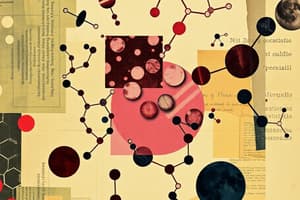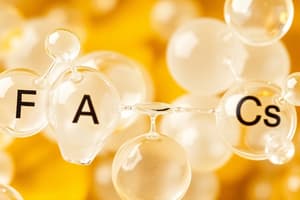Podcast
Questions and Answers
Which statement accurately describes the solubility of lipids?
Which statement accurately describes the solubility of lipids?
- Lipids are insoluble in water but soluble in non-polar solvents. (correct)
- Lipids are soluble in water and insoluble in non-polar solvents.
- Lipids are completely soluble in both water and non-polar solvents.
- Lipids are only soluble in polar solvents.
What characteristic distinguishes saturated fatty acids from unsaturated fatty acids?
What characteristic distinguishes saturated fatty acids from unsaturated fatty acids?
- Saturated fatty acids do not have double bonds. (correct)
- Saturated fatty acids contain double bonds.
- Saturated fatty acids are always liquid at room temperature.
- Saturated fatty acids contain an odd number of carbon atoms.
What is the primary function of phospholipids in biological systems?
What is the primary function of phospholipids in biological systems?
- Function solely as hormones.
- Act as energy storage molecules.
- Catalyze biochemical reactions.
- Serve as a major component of cellular membranes. (correct)
What type of lipids are esters of fatty acids that contain a nitrogen-containing base?
What type of lipids are esters of fatty acids that contain a nitrogen-containing base?
Which lipid is NOT classified as a simple lipid?
Which lipid is NOT classified as a simple lipid?
Which type of lipid contains carbohydrate components along with fatty acids and sphingosine?
Which type of lipid contains carbohydrate components along with fatty acids and sphingosine?
How are fatty acids typically found in natural fats and oils?
How are fatty acids typically found in natural fats and oils?
Which of the following accurately describes neutral lipids?
Which of the following accurately describes neutral lipids?
Which of the following compounds is synthesized similarly to cholesterol using isoprene units?
Which of the following compounds is synthesized similarly to cholesterol using isoprene units?
What is the primary role of corticosterone in the body?
What is the primary role of corticosterone in the body?
What can lipid peroxidation potentially cause in biological systems?
What can lipid peroxidation potentially cause in biological systems?
Which vitamin is produced from ergosterol when exposed to UV light?
Which vitamin is produced from ergosterol when exposed to UV light?
What is the stable conformation of a steroid nucleus referred to as?
What is the stable conformation of a steroid nucleus referred to as?
What is the primary characteristic of eicosanoids derived from polyunsaturated fatty acids?
What is the primary characteristic of eicosanoids derived from polyunsaturated fatty acids?
Which classification best describes fatty acids that contain only one double bond?
Which classification best describes fatty acids that contain only one double bond?
Which of the following is a characteristic feature of thromboxane?
Which of the following is a characteristic feature of thromboxane?
What is the main role of leukotrienes in the body?
What is the main role of leukotrienes in the body?
Which type of fatty acid has two or more double bonds?
Which type of fatty acid has two or more double bonds?
In what structure do saturated fatty acids usually form at low temperatures?
In what structure do saturated fatty acids usually form at low temperatures?
What is the name for the terminal methyl carbon in lipid structures?
What is the name for the terminal methyl carbon in lipid structures?
What type of lipid is primarily derived from hydrolysis of both simple and complex lipids?
What type of lipid is primarily derived from hydrolysis of both simple and complex lipids?
Which of the following is NOT a function of prostaglandins?
Which of the following is NOT a function of prostaglandins?
What is the significance of cis double bonds in naturally occurring unsaturated fatty acids?
What is the significance of cis double bonds in naturally occurring unsaturated fatty acids?
What component of cell membranes is crucial for signaling and membrane trafficking?
What component of cell membranes is crucial for signaling and membrane trafficking?
Which sphingolipid is mentioned as part of the outer leaflet of the cell membrane?
Which sphingolipid is mentioned as part of the outer leaflet of the cell membrane?
What role does phosphatidylserine play in cellular processes?
What role does phosphatidylserine play in cellular processes?
Which phospholipid can constitute 10% - 30% of brain and heart phospholipids?
Which phospholipid can constitute 10% - 30% of brain and heart phospholipids?
What are the two long chain hydrocarbon tails in glycerophospholipids and sphingolipids primarily responsible for?
What are the two long chain hydrocarbon tails in glycerophospholipids and sphingolipids primarily responsible for?
What is a major function of Phosphatidylinositol 4,5-bisphosphate (PiP2) in cellular signaling?
What is a major function of Phosphatidylinositol 4,5-bisphosphate (PiP2) in cellular signaling?
What is the structural resemblance of Plasmalogens characterized by?
What is the structural resemblance of Plasmalogens characterized by?
Which lipid type is primarily involved in forming complex lipid bilayers along with glycerophospholipids?
Which lipid type is primarily involved in forming complex lipid bilayers along with glycerophospholipids?
What can cause Respiratory Distress Syndrome in infants related to lipid components?
What can cause Respiratory Distress Syndrome in infants related to lipid components?
Which glycerophospholipid is also referred to as Cephalin?
Which glycerophospholipid is also referred to as Cephalin?
What is one of the protective effects associated with phosphatidylethanolamine?
What is one of the protective effects associated with phosphatidylethanolamine?
Where are glycolipids predominantly found in the body?
Where are glycolipids predominantly found in the body?
Which fatty acid characteristically found in galactosylceramide is mentioned in the content?
Which fatty acid characteristically found in galactosylceramide is mentioned in the content?
What role does cardiolipin play in cellular function?
What role does cardiolipin play in cellular function?
What is sulfogalactosylceramide more commonly known as?
What is sulfogalactosylceramide more commonly known as?
What condition is associated with decreased levels of cardiolipin?
What condition is associated with decreased levels of cardiolipin?
In which type of tissue are gangliosides present in high concentration?
In which type of tissue are gangliosides present in high concentration?
Which characteristic is true for gangliosides?
Which characteristic is true for gangliosides?
What is the precursor of phosphatidylglycerol?
What is the precursor of phosphatidylglycerol?
Which statement is true regarding the location of cardiolipin?
Which statement is true regarding the location of cardiolipin?
Flashcards are hidden until you start studying
Study Notes
Lipids Overview
- Lipids are heterogeneous compounds including fats, oils, steroids, and waxes.
- Insoluble in water but soluble in non-polar solvents (e.g., ether, chloroform).
- High energy value; lipids include essential fatty acids (EFAs), fat-soluble vitamins (FSVs), micronutrients, and hormones.
Simple Lipids
- Composed of esters formed from fatty acids (FAs) and alcohols.
- Types:
- Fats: fatty acids esterified with glycerol.
- Waxes: esters of fatty acids with high molecular weight monohydric alcohols.
Complex Lipids
- Esters of fatty acids that include one or more fatty acids and additional components.
- Types:
- Phospholipids: contain phosphoric acid and nitrogen bases (e.g., choline). Key examples include glycerophospholipids and sphingophospholipids.
- Glycolipids: consist of fatty acids, sphingosine, and carbohydrates.
- Other complex lipids: include sulfolipids, amino lipids, and lipoproteins.
Derived Lipids
- Formed from the hydrolysis of simple and complex lipids.
Fatty Acids
- Two types based on the presence of double bonds:
- Saturated: no double bonds.
- Unsaturated: one or more double bonds, further classified into monounsaturated and polyunsaturated.
- Eicosanoids are derived from 20-carbon polyenoic fatty acids.
Eicosanoids
- Subtypes include:
- Prostaglandins: local hormones, synthesized through cyclization of polyunsaturated fatty acids.
- Thromboxanes: contain a cyclopentane ring with an oxygen atom.
- Leukotrienes and lipoxins: inflammatory agents formed via the lipoxygenase pathway.
Structural Features of Fatty Acids
- Carbon chains are numbered from the carboxyl end (e.g., carbon 1, also known as alpha carbon).
- The last carbon (terminal) is referred to as omega (ω) carbon.
Membrane Lipids
- Glycerophospholipids and sphingolipids form the lipid bilayer essential for cell membranes.
- Phosphatidylethanolamine and phosphatidylserine play a significant role in cellular functions, including apoptosis.
Glycolipids
- Comprised of fats with attached carbohydrates, mainly distributed in nerve tissues.
- Galactosylceramide is a prominent example in the brain.
Cardiolipin
- Found solely in mitochondria, essential for mitochondrial function.
- Its deficiency may lead to mitochondrial dysfunction, impacting conditions like heart failure and aging.
Gangliosides
- Complex lipids prevalent in nervous tissues, characterized by sialic acid attachment, important for plasma membrane function.
Steroids
- Built from isoprene units and comprise three 6-carbon rings and one 5-carbon ring.
- Cortisol and corticosterone are glucocorticoids that manage stress and control inflammation.
Lipid Peroxidation
- A chain reaction initiated by free radicals that damages lipids and tissues.
- UV exposure may lead to lipid peroxidation, contributing to cancer and inflammatory diseases.
Polyprenoids
- Synthesized from 5-carbon isoprene units.
- Includes molecules like ubiquinone (involved in respiration) and plant-derived polyprenoids (e.g., fat-soluble vitamins A, D, E, K).
Studying That Suits You
Use AI to generate personalized quizzes and flashcards to suit your learning preferences.




